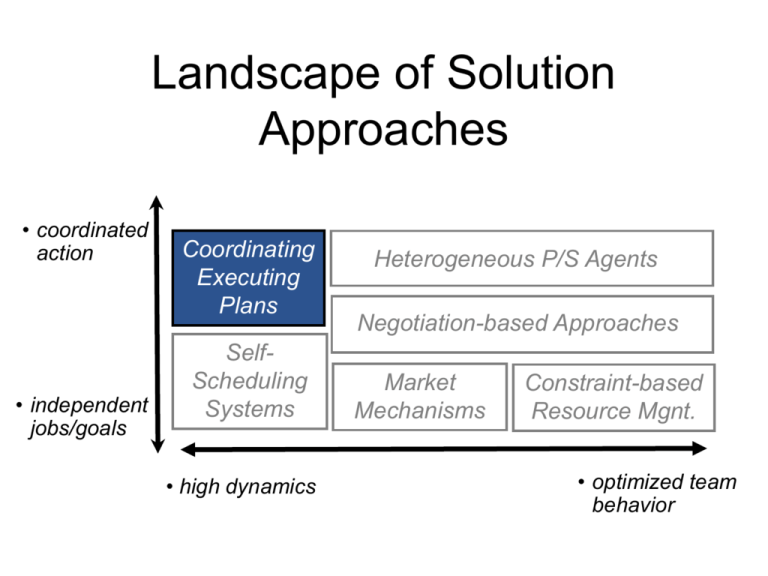CoordExecPlan
advertisement

Landscape of Solution Approaches • coordinated action • independent jobs/goals Coordinating Executing Plans SelfScheduling Systems • high dynamics Heterogeneous P/S Agents Negotiation-based Approaches Market Mechanisms Constraint-based Resource Mgnt. • optimized team behavior Coordinating executing plans QuickTime™ and a TIFF (LZW) decompressor are needed to see this picture. • Multiagent Plan execution semantics • Domain-independent Teamwork & Collaboration – Example: Joint Intentions Image courtesy: www.5DT.com Explicit/Procedural Plan Coordination (without underlying semantics) • Simple Idea: Provide specific plans to coordinate – When at holding point, scout flies to battle position then informs those waiting at holding point that the battle position is scouted – To fly in formation, each agent is assigned someone to follow in formation (follow-the-leader) • Problem: Fragile! Difficult to get it right for all contingencies Problems with Explicit, semantics-free Plans No framework to anticipate failures; numerous ad-hoc plans • Upon reaching the holding area, the company waited, while the scout started flying forward. – Unfortunately, the scout unexpectedly crashed into a hillside. Hence, the rest of the company just waited indefinitely at the holding area, waiting to receive a message from the (crashed) scout that the battle position was scouted. • Upon recognizing that the mission was completed, one company member (the commander) returned to home base, abandoning others at the battle position – The commander’s “follower” was unexpectedly shot down, and hence it failed to coordinate with others in its company. Joint-Intentions lead to Execution Robustness • Team goals/plans are represented explicitly – Individual intentions = scheduled actions • Team members have commitments and responsibilities toward others when executing a team activity. – Commitments to not just local actions, but achievement of overall goal • Other approaches possible, e.g. SharedPlans [Grosz & Kraus 96] – Tries to avoid need for joint mental attitude – Hierarchical plans Explicit Model of Teamwork using Joint-Intentions (Cohen & Levesque) • A team jointly intends a team action – if team members are jointly committed to completing that team action – while mutually believing that they were doing it (not unintentional) • Joint commitment is defined as joint persistent goal (JPG) – JPG (,p) = “Team has a joint persistent goal to achieve p” – entire team can be treated as jointly committed to a team plan • Bunch of helicopters flying on own to a waypoint IS NOT the same as a team flying to a waypoint. – Difference may be only in mental state, if nothing goes wrong… • Success of the team may not require each individual to successfully complete its journey Conditions for JPG to Hold • • • All team members in mutually believe ¬p currently. All team members mutually know they want p eventually. All team members mutually believe that until p is mutually known to be achieved, unachievable or irrelevant, they mutually believe that they each hold p as a weak achivement goal (WAG): • • Either privately believes ¬p and wants p eventually, Or, having privately discovered p to be achieved, unachievable or irrelevant, has committed to having this private belief become ‘s mutual belief Example: STEAM—a Shell for TEAMwork [Tambe] • Computationally tractable Joint-Intention framework to handle – – – – Communication costs Uncertainty about state other team members Single and Multiple Team member failure Evolving hierarchy of joint events • Domain-independent approach to establish and maintain joint-intentions • Organizational roles & dependencies • Folds in some of the hierarchical representation used by SharedPlans theory STEAM Overview Team-oriented Programs: Explicit team reactive plans/operators – – Hierarchically expand into individual plans/operators Roles, e.g., lead role in formation flying, with constraints Domain-independent plans for – – Coherence Preservation [establish joint commitments] Maintenance & Repair [monitor and fix, or decommit] Execute [Company A] mission [Company A] Fly-flight-plan Engage [Attack Platoon A1] Fly-route Employ-weapons [Individual A1-a] Lead Follow Situated Plans (Reactive Plans) • Situated/reactive plan consists of: – Preconditions, matched with agents’ beliefs – Termination conditions, to terminate plan when matched – Plan body to execute when plan activated • May invoke external or internal or no action • Example: Plan Attend-Agents-Workshop – Precondition: Saw agents workshop call for participation – Body: Register for workshop, fly, attend sessions, flyback.. – Termination condition: Attended agents workshop Coherence Preservation: Establish Commitments 1. Team leader broadcasts a message to the team to establish PWAG (persistent weak achievement goal) to operator OP. Leader now establishes PWAG. If JPG(,OP) not established within time limit, repeat broadcast. 2. Subordinates i in the team wait until they receive leader’s message. Then, turn by turn, broadcast to establishment of PWAG for OP; and establish PWAG. 3. Wait until i, i establish PWAG for OP; establish JPG(,OP) Hierarchy of jointly committed team plans implies coherence when executing & terminating team plans Maintenance & Repair All team plans executed by forming & terminating joint commitments: • Request-confirm exchanges so all team members select & commit • Establish mutual belief for achieved, unachievable,… to terminate • Explicit constraints on individual/subteam roles & team goal • Form, repair, terminate team plans: All communication in STEAM Example: Team of helicopters jointly commit to “execute mission” • If commander privately believes mission unachievable… • Commander must establish mutual belief in termination condition • It communicates (and confirms) mission unachievable: no one left behind Maintenance and Repair, cont. • Scouting failure example: Wait-for-battle-position-scouted is the team plan – AND-combination: Scout and Non-scout roles in team plan – If scout crashes, the scout role is not fulfilled – AND-combination implies that the team plan fails • Joint commitment to replan by reorganization, if critical failures – Determine candidates for roles via capability matching – Candidates for roles ensure no conflicting critical commitments – Individual/subteam may volunteer • If multiple candidates, compare based on capability – Highest capability agent wins • Scouting failure example continued – Locate other pilots capable of scouting – New candidate scout ensure no conflicting commitments – Candidate scout(s) volunteer – Best capability scout wins






